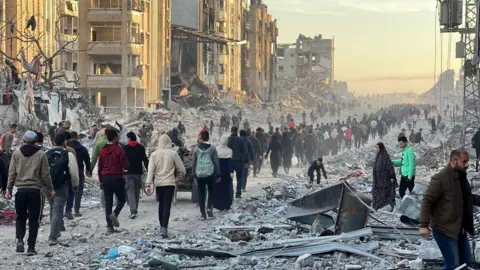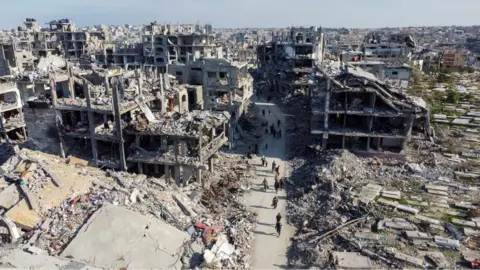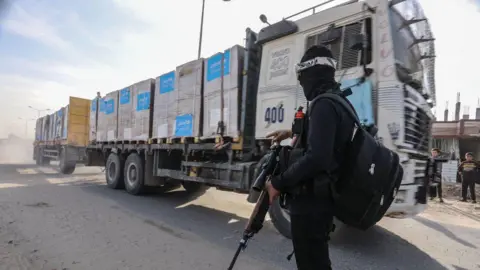Gaza correspondent
BBC News
 Getty Images
Getty ImagesAs Palestinians poured onto the streets of Gaza to celebrate the ceasefire, moments of joy faded for many as they returned to their homes to be met by destruction.
In Jabalia, a town in northern Gaza that is home to the largest refugee camp in the strip, pictures and videos shared by residents revealed entire neighbourhoods reduced to rubble.
Returning to the al-Faluja area of Jabalia, Duaa al-Khalidi told BBC News: “I survived with my two daughters, we came out from under the rubble of our house.
“Here, beneath the debris, the bodies of my husband, my mother-in-law, and my sister-in-law have remained buried since 9 October.”
The 28-year-old mother of two continued: “I want nothing but their bodies so I can bury them with dignity.”
Jabalia camp, once home to over 250,000 Palestinians, became the site of the largest and most violent Israeli military operation during the war, with around 4,000 Palestinians killed, according to the Hamas-run health ministry.
Also returning to Jabalia was Hussein Awda, who documented his journey back from Gaza City.
The professional weightlifter, who has represented Palestine internationally, lost 10 members of his family at the start of the war.
“The best thing that happened today is that after 100 days, I was able to visit my family’s grave and pray for them,” he shared.
He also posted a video revealing the devastation to his three-storey home and sports club he owns.
“Here I lost the people closest to my heart – my brothers, my sons, my source of livelihood. The war killed everything beautiful inside us.”
 Reuters
ReutersIn the southern city of Khan Younis, armed Hamas fighters drove through the streets to cheering crowds and chanting, according to Reuters news agency.
Hamas policemen, in police uniforms, were also deployed in some areas after months of hiding out of sight to avoid Israeli strikes.
Gaza City resident Ahmed Abu Ayham, who has been sheltering with his family in Khan Younis, told Reuters that his home city was “dreadful”.
In the city, which has suffered the heaviest destruction according to experts, people were seen waving the Palestinian flag and filming scenes on their mobile.
But the 40-year-old said it was no time for celebrations, despite the fact the ceasefire might save lives.
“We are in pain, deep pain and it is time that we hug one another and cry,” he said.
Gazans were also on the move to the southern city of Rafah near the Egyptian border.
Mohammed Suleiman told BBC Arabic’s Gaza Lifeline: “Thank God, we have received the news of the ceasefire coming into effect with joy and happiness.
“God willing, things will change for the better and we will return to Rafah. I hope every displaced person will safely return to his home.”
Many fled the city after Israel ordered their evacuation before starting an operation in the southern Gaza city.
In Rafah, Muhammad al-Jamal, a journalist for Palestinian newspaper Al-Ayyam, reflected on his own loss.
“The house was razed to the ground; everything was reduced to rubble,” he said. “The chicken coop and the fig tree whose fruits we shared together are now a thing of the past.”
 Getty Images
Getty ImagesThe fragility of the ceasefire agreement became evident in its initial hours.
The truce finally took effect after a three-hour delay, during which 19 Palestinians were reportedly killed in what Israel said were strikes on “terror targets”.
By the afternoon, three Israeli female hostages were back in Israel, as part of a six-week first phase that will see 33 hostages released.
But people in Gaza remain fearful that the truce may falter once again.


